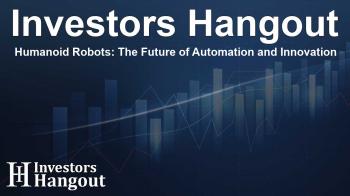Humanoid Robots: The Future of Automation and Innovation

Humanoid Robots: The Future of Automation
The landscape of technology is rapidly changing, and humanoid robots are at the forefront of this transformation. The market for these robots is predicted to expand significantly, reaching $3.83 billion in the coming years, showcasing a remarkable compound annual growth rate (CAGR) of 45.7%. The driving forces behind this growth are the concerted efforts of technology firms that invest heavily in artificial intelligence (AI) and robotics.
Investment Dynamics in the Humanoid Robot Market
In recent years, substantial investments have fueled the growth of the humanoid robot sector. Major companies have stepped up their research and development initiatives, focusing on creating advanced humanoid robots capable of performing various tasks. For instance, a notable investment was made by Figure, which secured $675 million from prominent backers, including OpenAI and Microsoft.
Leading Companies in the Field
Some of the most influential players in the humanoid robot market include Agility Robotics, Boston Dynamics, Figure, and Tesla. Each of these companies is making significant strides in developing robots that can navigate complex environmental tasks, enhance workplace efficiency, and tackle challenges across various industries, including logistics, healthcare, and retail.
Biped Robots: The Leaders of the Pack
Among the different types of humanoid robots, biped robots are especially noteworthy. These robots mimic human movement and mobility, providing a solution that is both versatile and effective across multiple industries. With ongoing innovations, such as the development of robots like Boston Dynamics' Atlas and Tesla's Optimus, these machines are becoming integral to activities that require dexterity and adaptability.
Applications in Education and Entertainment
The application of humanoid robots extends significantly into education and entertainment. Schools are leveraging these robots to facilitate interactive learning experiences, fostering student engagement with technology and robotics. For instance, over 100 Pepper robots have been deployed in educational institutions to assist with personalized learning. In entertainment venues, humanoid robots are redefining how audiences interact with performances through enhanced storytelling and engagement.
North America's Dominance in the Humanoid Robot Market
When discussing the humanoid robot market, North America stands out as a key player. The region is experiencing a surge in the adoption of humanoid robots in diverse settings, such as public relations, caregiving, and education. Notably, the increasing demand for robots capable of search and rescue operations, personal assistance, and entertainment is contributing to market growth.
Technological Advancements Driving Growth
Artificial intelligence has been central to enhancing the functionalities of humanoid robots. With applications ranging from machine learning to natural language processing, these technologies enable robots to complete increasingly complex tasks while adapting to human emotions and environments. This integration of AI is pushing for broader adoption across sectors such as healthcare and manufacturing, marking a new era of operational efficiency.
Emerging Opportunities in the Humanoid Robot Sector
The future of the humanoid robot market looks promising, driven by a series of attractive opportunities. The education and medical industries particularly show a growing demand for humanoid robots, paving the way for innovative applications. Meanwhile, product launches and strategic contracts are anticipated to create lucrative prospects for market players.
Market Growth Projections
Furthermore, the Asia Pacific region is expected to experience the most considerable growth with a projected CAGR of 48.0%. This growth reflects not only the escalating demand for robots in various sectors but also the continuous evolution in technology that supports such advancements.
Frequently Asked Questions
What is the forecast growth rate for the humanoid robot market?
The humanoid robot market is expected to grow at a compound annual growth rate (CAGR) of 45.7%, reaching $3.83 billion by 2029.
Which major companies are leading the humanoid robot industry?
Agility Robotics, Boston Dynamics, Figure, and Tesla are some of the prominent players in the humanoid robot market.
How are humanoid robots being utilized in education?
Humanoid robots are used in schools for interactive learning experiences, helping students engage with technology and robotics concepts.
What technological advancements are impacting humanoid robots?
Artificial intelligence, machine learning, and natural language processing are enhancing the capabilities and functionality of humanoid robots.
What regions are expected to show the most growth in humanoid robots?
The Asia Pacific region is projected to grow at the highest CAGR of 48.0% during the forecast period as demand for humanoid robots continues to rise.
About The Author
Contact Hannah Lewis privately here. Or send an email with ATTN: Hannah Lewis as the subject to contact@investorshangout.com.
About Investors Hangout
Investors Hangout is a leading online stock forum for financial discussion and learning, offering a wide range of free tools and resources. It draws in traders of all levels, who exchange market knowledge, investigate trading tactics, and keep an eye on industry developments in real time. Featuring financial articles, stock message boards, quotes, charts, company profiles, and live news updates. Through cooperative learning and a wealth of informational resources, it helps users from novices creating their first portfolios to experts honing their techniques. Join Investors Hangout today: https://investorshangout.com/
The content of this article is based on factual, publicly available information and does not represent legal, financial, or investment advice. Investors Hangout does not offer financial advice, and the author is not a licensed financial advisor. Consult a qualified advisor before making any financial or investment decisions based on this article. This article should not be considered advice to purchase, sell, or hold any securities or other investments. If any of the material provided here is inaccurate, please contact us for corrections.

